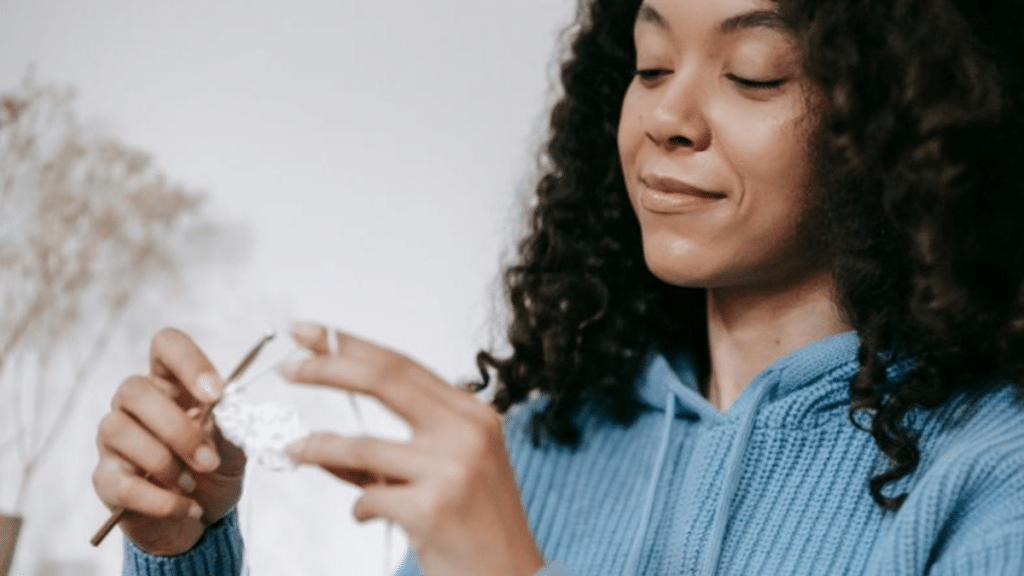In today’s fast-paced world, finding hobbies that can help reduce stress and provide a creative outlet is becoming increasingly essential. One craft that has gained recognition for its soothing benefits is crocheting. More than just a fun way to make scarves, blankets, and other handmade items, crochet also offers numerous mental and physical health benefits. Whether you’re a seasoned pro or someone just learning how to crochet, this activity can greatly improve your overall well-being.
How Crochet Reduces Stress
The relaxing power of crochet comes from its repetitive, rhythmic motions, which help calm the mind and reduce stress. Much like meditation, the simple act of pulling yarn through loops focuses your thoughts and soothes the nervous system. This gentle, repetitive motion creates a mental break from the hustle of daily life, providing a much-needed sense of relaxation.
In fact, research shows that repetitive activities, like crochet, can lower cortisol levels — our body’s stress hormone. Lowering these levels not only reduces anxiety but also helps improve sleep and fosters an overall feeling of well-being. Many crocheters find it the perfect way to unwind after a long day or to cope with stressful moments.
Improving Focus and Mindfulness Through Crochet
Along with its stress-reducing effects, crochet can also enhance focus and mindfulness. The concentration required to follow a crochet pattern keeps you grounded in the present moment, which is a core element of mindfulness. This focus on the task at hand promotes mental clarity and reduces distractions.
For those who often struggle with staying focused or dealing with racing thoughts, crochet offers a great way to develop mental discipline. Counting stitches and keeping track of patterns redirects attention away from worries or negative thoughts, fostering a “flow” state — a mental space where you’re completely absorbed in the activity, and time seems to fly by.
Physical Health Benefits of Crochet
Crochet isn’t just good for the mind — it also offers surprising physical benefits. For individuals dealing with conditions like arthritis or recovering from hand injuries, crochet can serve as a gentle exercise to improve dexterity and flexibility in the hands. The repetitive movements involved help strengthen the muscles in your hands, improving fine motor skills in the process.
This low-impact activity can even be a form of physical therapy, as the controlled motions help maintain flexibility in the hands and wrists without straining them. Plus, the sense of accomplishment from finishing a crochet project can boost your mood, further contributing to overall health by strengthening the connection between mind and body.

Starting Your Crochet Journey
If you are ready to learn crochet, getting started is simpler than you might think. Here’s what you’ll need to begin your journey into this rewarding yarn craft.
Essential Crochet Supplies
To learn crocheting, you will need just a few basics: a crochet hook (size 5 mm is a good choice for beginners) and worsted weight yarn (preferably cotton or acrylic in a light color) that’s easy to work with. Other essential tools include scissors for cutting the yarn and a yarn needle to weave in the ends once you finish your project. These tools are everything you need to learn to crochet and start practicing your first stitches.
The Basics of Crochet
Before diving into your first projects, it’s crucial to learn the basic stitches. Every crochet pattern starts with a slip knot and chain stitch, which are the essential building blocks of the craft. These initial techniques not only lay the foundation for every crochet project but also offer a great way to practice proper hand positioning for holding the yarn and hook.
Once you’ve got the hang of these basics, the next step is learning the single crochet stitch. This basic crochet stitch produces a firm, dense fabric and is a staple in many beginner-friendly projects. Equally important are the double crochet stitch and half double crochet stitch, which are looser and work up faster, creating a more open, airy structure.
As you gain confidence in these essential stitches, you will be ready to take on simple projects like scarves, dishcloths, or granny squares. Plenty of free crochet patterns can be found all over the web. Be sure to pick projects designed with beginners in mind that provide easy-to-follow instructions for those just starting out.
Crochet Resources for Absolute Beginners
There are multiple resources to help you learn how to crochet. For a comprehensive tutorial, discover YourCrochet’s free online course, How to Crochet for Beginners: A Complete Guide for Everyone. This guide covers everything from learning how to hold the hook and yarn, explaining crochet terms, reading yarn labels to teaching you how to crochet the most common stitches. Accompanied by step-by-step video tutorials it’s a reliable source perfect for those who want to learn crochet.
Conclusion
Crocheting is a powerful tool for enhancing mental and physical wellness. From relieving stress to improving focus and strengthening hand dexterity, it offers a wide range of benefits for both body and mind. Whether you have been crocheting for years or would like to learn to crochet, you can always incorporate this rewarding activity into your life.
